Expert sommeliers can take a whiff of a glass of wine and tell you a lot about what’s in your pinot noir or cabernet sauvignon. A team of physicists at CU Boulder and the National Institute of Standards and Technology (NIST) have achieved a similar feat of sensing, only for a much wider range of substances.
The group has developed a new laser-based device that can take any sample of gas and identify a huge variety of the molecules within it. It is sensitive enough to detect those molecules at minute concentrations all the way down to parts per trillion.
Its design is also simple enough that researchers could employ the method quickly and at a low cost in a range of settings, from diagnosing illnesses in human patients to tracking greenhouse gas emissions from factories.
